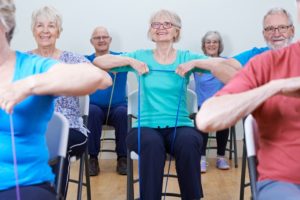
Furthermore, it’s important to understand which exercises are safe to perform and which to steer clear of as it can put your bones at risk.
Studies have shown that exercise in osteoporosis may help reduce the risk of falls by 25 percent and the risk of hip fractures by five percent. The main goal of exercise in osteoporosis is to reduce the risk of falls as that can lead to several complications along with injury which can worsen a person’s health.
Exercises to Perform for Osteoporosis
The best type of exercises for a person with osteoporosis are weight-bearing exercises which means exercises that move against gravity while remaining upright. If you are just starting out exercising, then it is recommended you work with a trainer or physical therapist in order to reduce your risk of injury and to ensure you are performing these exercises correctly. Exercises should also be low impact, meaning they do not put added stress on the bones or joints.
The intensity of exercises should increase gradually, and movements should not be sudden or sudden.
Here is a list of exercises which are deemed safe for patients with osteoporosis.
Foot stomps
This is a simple exercise easily done by standing and stomping your feet as if you are crushing something beneath them. For added stability hold on to a railing, chair, or table.
Bicep curl
By holding light weights in each hand, simply curl up your forearm by only bending at the elbow to bring the weights up. Once curled up, bring the weight back down.
Shoulder lifts
Holding either weights or resistance bands, bring your arm upward in front of you without bringing your arm higher than your shoulder. Once up, slowly bring it back down. Repeat a few times with each arm.
Hamstring curl
By standing with feet shoulder width apart, raise of your foot to bring your heel as close to your buttocks as possible and then bring it back down. Alternate between legs.
Hip leg lifts
Start by standing on both feet. Slowly lift your leg outward to the side while your foot is flexed. Try to keep your upper body upright.
Squats
Feet shoulder width apart, lower yourself down as if you were about to sit on a chair. Keep your back straight and buttocks tight. Slowly raise yourself back up to standing position.
Ball sit
Sit on a exercise ball and try to maintain balance as you lift your arms up by your sides. Try to hold this position for at least a minute.
Standing on one leg
Feel free to use a chair, table, or railing for support and lift one leg off the ground and try to balance for a while. Alternate legs.
Walking
Walking is an easy, low-impact exercise that is not only good for your bones but overall health. As long as you have the proper footwear you can integrate walking into your daily life.
Dancing
Dancing is a fun way to improve your bones along with staying social. Take up a dance class so that you are properly guided and supervised.
Tai chi
Tai chi is an Ancient Chinese exercise that involves gentle stretching and movements. Plus, there is plenty of evidence to support that tai chi is beneficial to bones.
Yoga
Although yoga is generally safe for all, if you have osteoporosis you will want to take extra precautions and let the instructor know so they can provide you with feedback and advice to perform it properly and safely.
Which Exercises to Avoid for Osteoporosis?
Exercises to avoid with osteoporosis are high-impact exercises. These include running/jogging, high-intensity dancing, hiking, jumping rope, stair climbing, tennis, and squash. You will also want to avoid exercises that cause sudden movements, instability, rotating movements (such as golf), and movements that cause the body to jerk.
Tips While Performing Exercises for Osteoporosis
If you have osteoporosis and want to begin performing exercises, then keep these helpful tips in mind:
- Some weight-bearing exercise should be completed for at least 30 minutes.
- On days where you may not be able to exercise, perform lifestyle habits that promote exercise like taking the stairs or parking your car further away from your destination.
- Muscle-strengthening exercises should be performed at least twice a week. Try to target all major muscle groups on different days.
- Even the smallest amount of exercise a day is enough to start strengthening bones, so even if you can’t dedicate 30 to 60 minutes, even small bouts is okay.
- Balance, mobility, and functional exercises should be completed daily.
- Ensure your exercise doesn’t cause you any pain.
- Do a variety of exercises as to work all areas of your body.
- Pick exercises and activities which you enjoy so that you don’t get bored and stick to it.
By working closely with your doctor and physical therapist, you can begin to strengthen your bones and reduce your risk of falls and fractures, even if you have osteoporosis.
Also read: